1993 CHEVROLET ASTRO PASSENGER change time
[x] Cancel search: change timePage 172 of 345
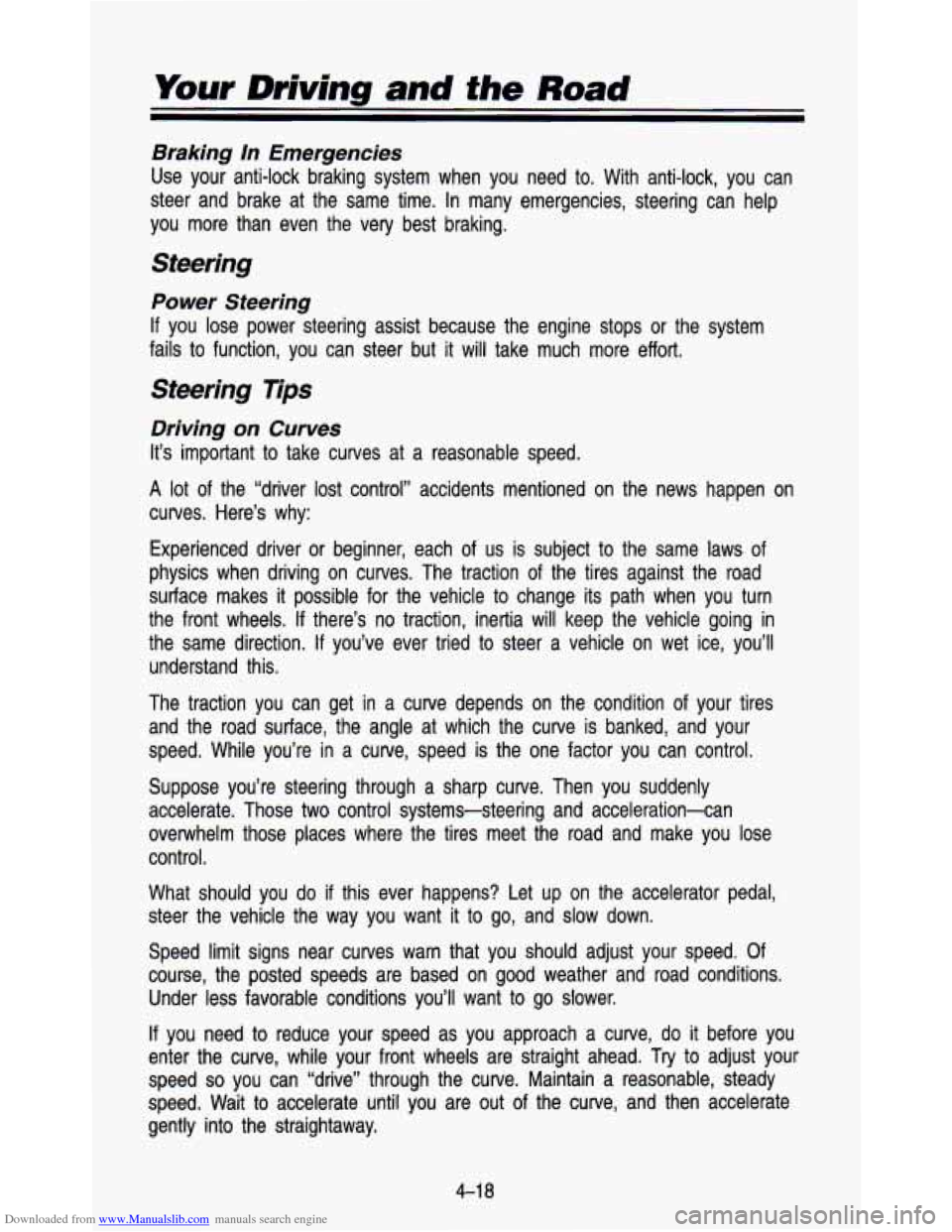
Downloaded from www.Manualslib.com manuals search engine Your Driving and the Road
Braking In Emergencies
Use your anti-lock braking system when you need to. With anti-\
lock, you can
steer and brake at the same time. In many emergencies, steering can help
you more than even the very best braking.
Steering
Power Steering
If you lose power steering assist because the engine stops or the\
system
fails
to function, you can steer but it will take much more effort.
Steering Tips
Driving on Curves
It’s important to take curves at a reasonable speed.
A lot of the “driver lost control” accidents mentioned on the news happen on
curves. Here’s why:
Experienced driver or beginner, each of us
is subject to the same laws of
physics when driving on curves. The traction of the tires against the \
road
surface makes it possible for the vehicle
to change its path when you turn
the front wheels.
If there’s no traction, inertia will keep the vehicle going in \
the same direction.
If you’ve ever tried to steer a vehicle on wet ice, you’ll
understand this.
The traction you can get in
a curve depends on the condition of your tires
and the road surface, the angle at which the curve is banked,\
and your
speed. While you’re in a curve, speed is the one factor you can control.
Suppose you’re steering through a sharp curve. Then you suddenly
accelerate. Those two control systems-steering and acceleration-can
overwhelm those places where the tires meet the road and make \
you lose
control.
What should you
do if this ever happens? Let up on the accelerator pedal,
steer the vehicle the way you want it
to go, and slow down.
Speed limit signs near curves warn that you should adjust your\
speed. Of
course, the posted speeds are based on good weather and road \
conditions. Under less favorable conditions you’ll want
to go slower.
If you need to reduce your speed as you approach a curve, do it before you
enter the curve, while your front wheels are straight ahead.
Try to adjust your
speed
so you can “drive” through the curve. Maintain a reasonable, steady
speed. Wait to accelerate until you are out of the curve, and\
then accelerate gently into the straightaway.
4-1 8
Page 176 of 345
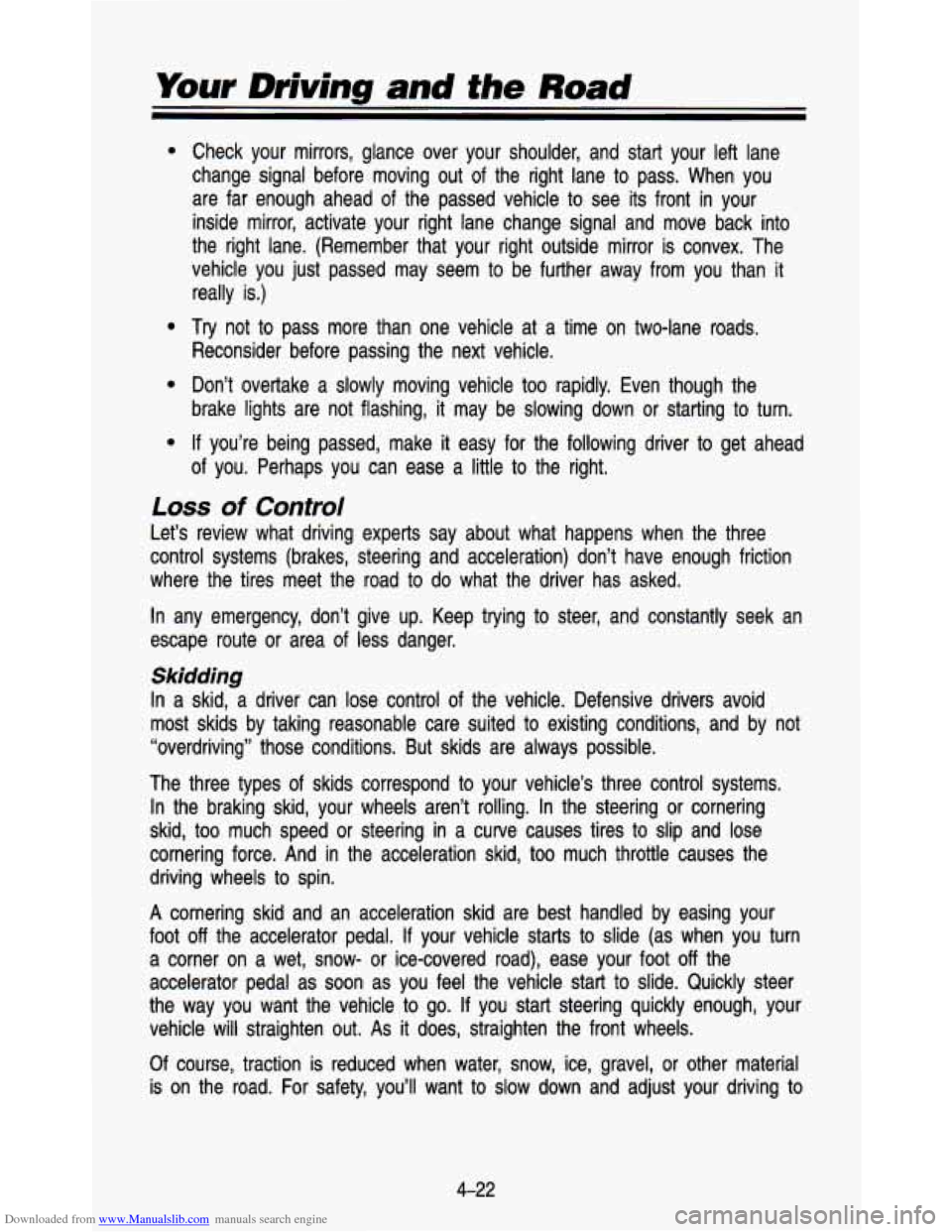
Downloaded from www.Manualslib.com manuals search engine Your Driving and the Road
0
Check your mirrors, glance over your shoulder, and start your \
left lane
change signal before moving out of the right lane
to pass. When you
are far enough ahead of the passed vehicle
to see its front in your
inside mirror, activate your right lane change signal and move \
back into
the right lane. (Remember that your right outside mirror is c\
onvex. The
vehicle you just passed may seem
to be further away from you than it
really
is.)
Try not to pass more than one vehicle at a time on two-lane roads.
Reconsider before passing the next vehicle.
Don’t overtake a slowly moving vehicle
too rapidly. Even though the
brake lights are not flashing, it may be slowing down or starting
to turn.
If you’re being passed, make it easy for the following driver
to get ahead
of you. Perhaps you can ease a little
to the right.
Loss of Control
Let’s review what driving experts say about what happens whe\
n the three
control systems (brakes, steering and acceleration) don’t ha\
ve enough friction
where the tires meet the road
to do what the driver has asked.
In any emergency, don’t give up. Keep trying
to steer, and constantly seek an
escape route or area of less danger.
Skidding
In a skid, a driver can lose control of the vehicle. Defensive drivers avoid
most skids by taking reasonable care suited to existing conditions, and by not
“overdriving” those conditions. But skids are always possib\
le.
The three types
of skids correspond to your vehicle’s three control systems.
In the braking skid, your wheels aren’t rolling. In the steering or cornering
skid,
too much speed or steering in a curve causes tires to slip and lose
cornering force. And in the acceleration skid,
too much throttle causes the
driving wheels
to spin.
A cornering skid and an acceleration skid are best handled by easing your
foot
off the accelerator pedal. If your vehicle starts to slide (as when you turn
a corner on a wet, snow- or ice-covered road), ease your foo\
t
off the
accelerator pedal
as soon as you feel the vehicle start to slide. Quickly steer
the way you want the vehicle
to go. If you start steering quickly enough, your
vehicle will straighten out.
As it does, straighten the front wheels.
Of course, traction is reduced when water, snow, ice, gravel, or other material
is on the road. For safety, you’ll want
to slow down and adjust your driving to
4-22
Page 177 of 345
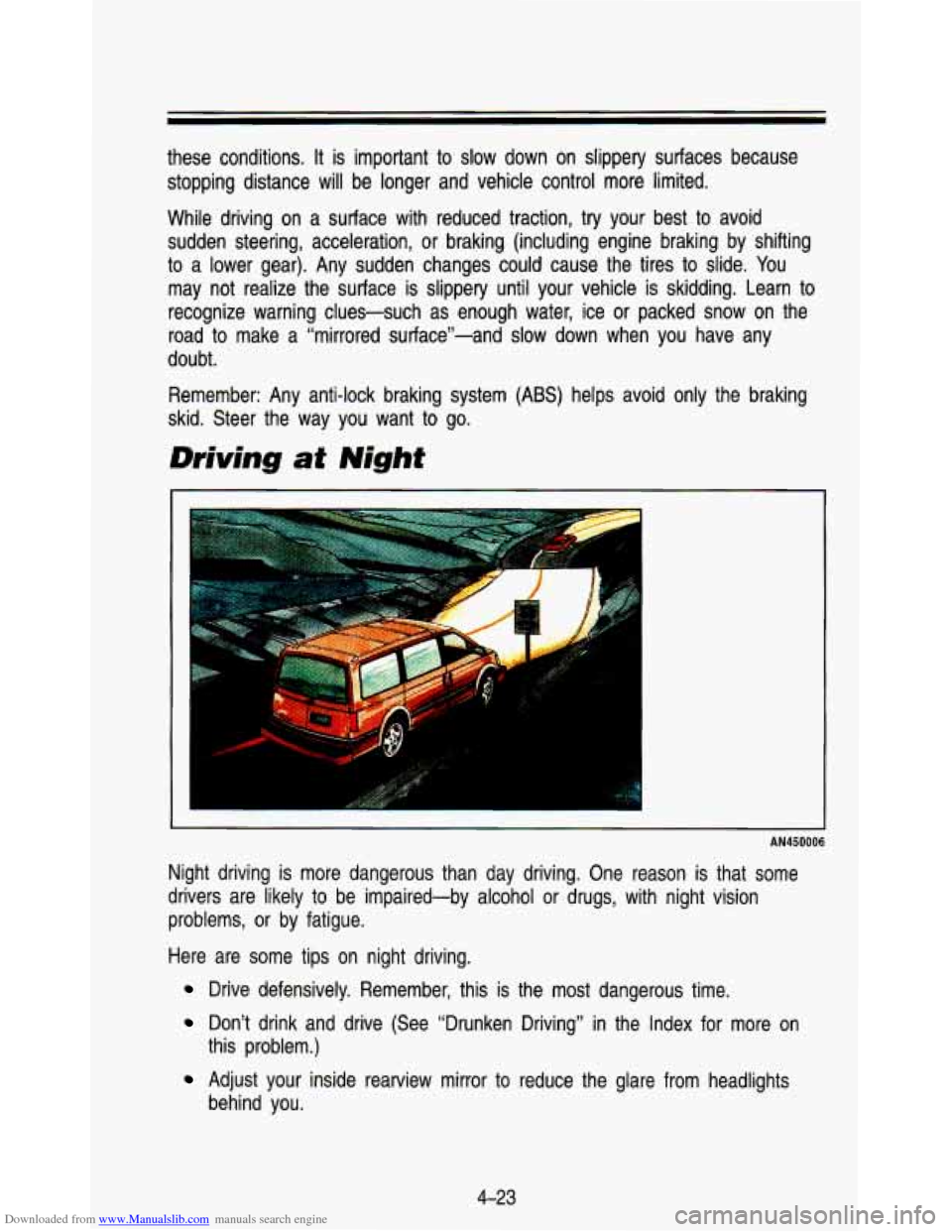
Downloaded from www.Manualslib.com manuals search engine these conditions. It is important to slow down on slippery surfaces because
stopping distance will be longer and vehicle control more limited.
While driving on a surface with reduced traction, try your best to avoid
sudden steering, acceleration, or braking (including engine brak\
ing by shifting
to a lower gear). Any sudden changes could cause the tires to s\
lide. You
may not realize the surface is slippery until your vehicle is skidding. Learn to
recognize warning clues-such as enough water, ice or packed sno\
w on the
road to make a “mirrored sutface”-and slow down when you have any\
doubt.
Remember: Any anti-lock braking system
(ABS) helps avoid only the braking
skid. Steer the way you want to go.
Driving at Night
AN450006
Night driving is more dangerous than day driving. One reason is that some
drivers are likely to be impaired-by alcohol or drugs, with night vision
problems, or by fatigue.
Here are some tips on night driving.
Drive defensively. Remember, this is the most dangerous time.
Don’t drink and drive (See “Drunken Driving” in the Index for more on
Adjust your inside rearview mirror to reduce the glare from he\
adlights
this problem.)
behind you.
4-23
Page 187 of 345
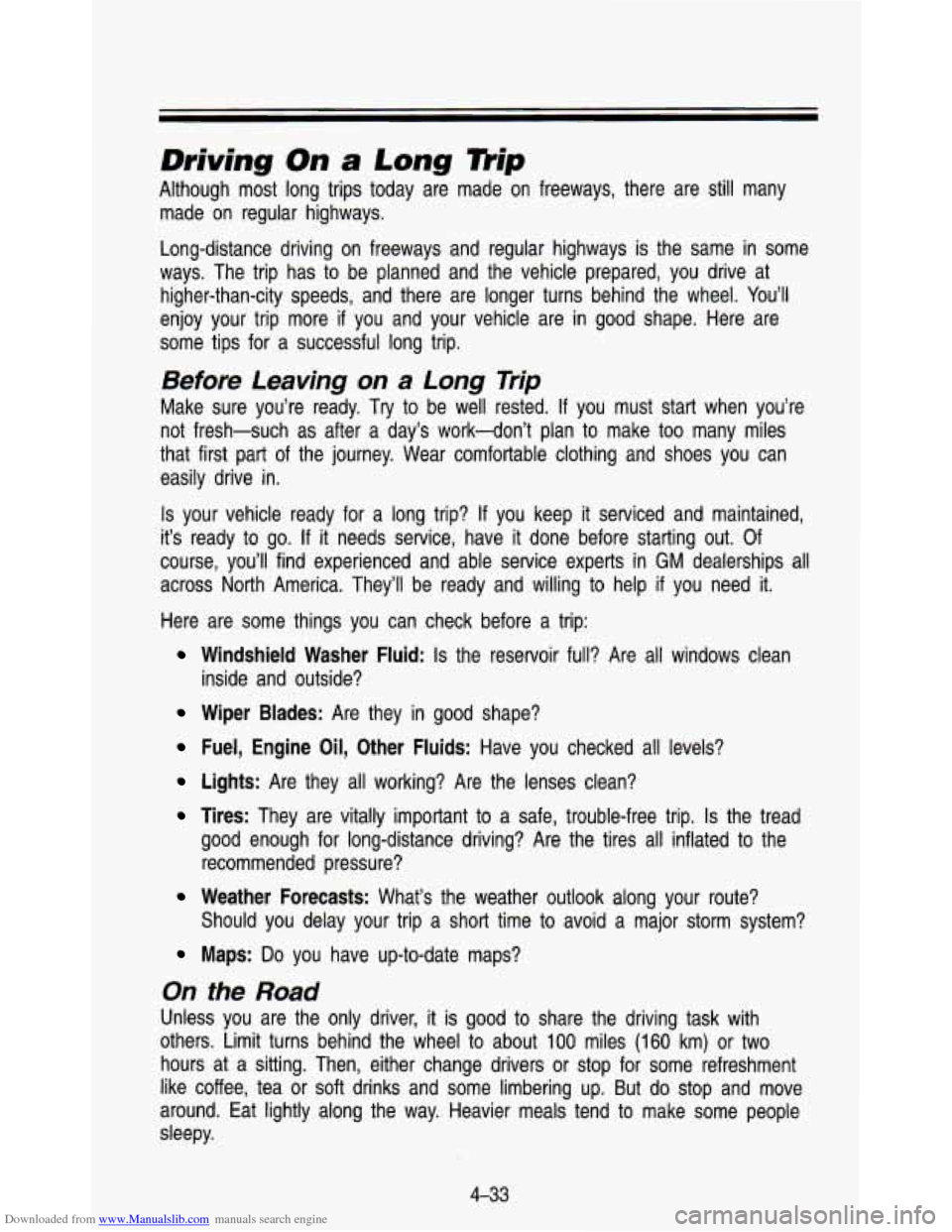
Downloaded from www.Manualslib.com manuals search engine Driving On a Long nip
Although most long trips today are made on freeways, there are still many
made on regular highways.
Long-distance driving on freeways and regular highways is the same in some
ways. The trip has to be planned and the vehicle prepared, you drive at
higher-than-city speeds, and there are longer turns behind the wheel. You’ll
enjoy your trip more
if you and your vehicle are in good shape. Here are
some tips for a successful long trip.
Before Leaving on a Long Trip
Make sure you’re ready. Try to be well rested. If you must start when you’re
not fresh-such as after a day’s work-don’t plan to make too many miles
that first part of the journey. Wear comfortable clothing and shoes you can
easily drive in.
Is your vehicle ready for a long trip? If you keep it serviced and maintained,
it’s ready to
go. If it needs service, have it done before starting out. Of
course, you’ll find experienced and able service experts in
GM dealerships all
across North America. They’ll be ready and willing to help
if you need it.
Here are some things you can check before a trip:
Windshield Washer Fluid: Is the reservoir full? Are all windows clean
Wiper Blades: Are they in good shape?
Fuel, Engine Oil, Other Fluids: Have you checked all levels?
Lights: Are they all working? Are the lenses clean?
Tires: They are vitally important to a safe, trouble-free trip. Is the tread
good enough for long-distance driving? Are the tires all inflated to the
recommended pressure?
Should you delay your trip a short time to avoid a major storm system?
inside and outside?
Weather Forecasts: What’s the weather outlook along your route?
Maps: Do you have up-to-date maps?
On the Road
Unless you
are the only driver, it is good to share the driving task with
others. Limit turns behind the wheel to about
100 miles (160 km) or two
hours- at a sitting. Then, either change drivers or stop for some refres\
hment
like coffee, tea or soft drinks and some limbering up. But
do stop and move
around. Eat lightly along the way. Heavier meals tend to make some people
sleepy.
4-33
Page 231 of 345
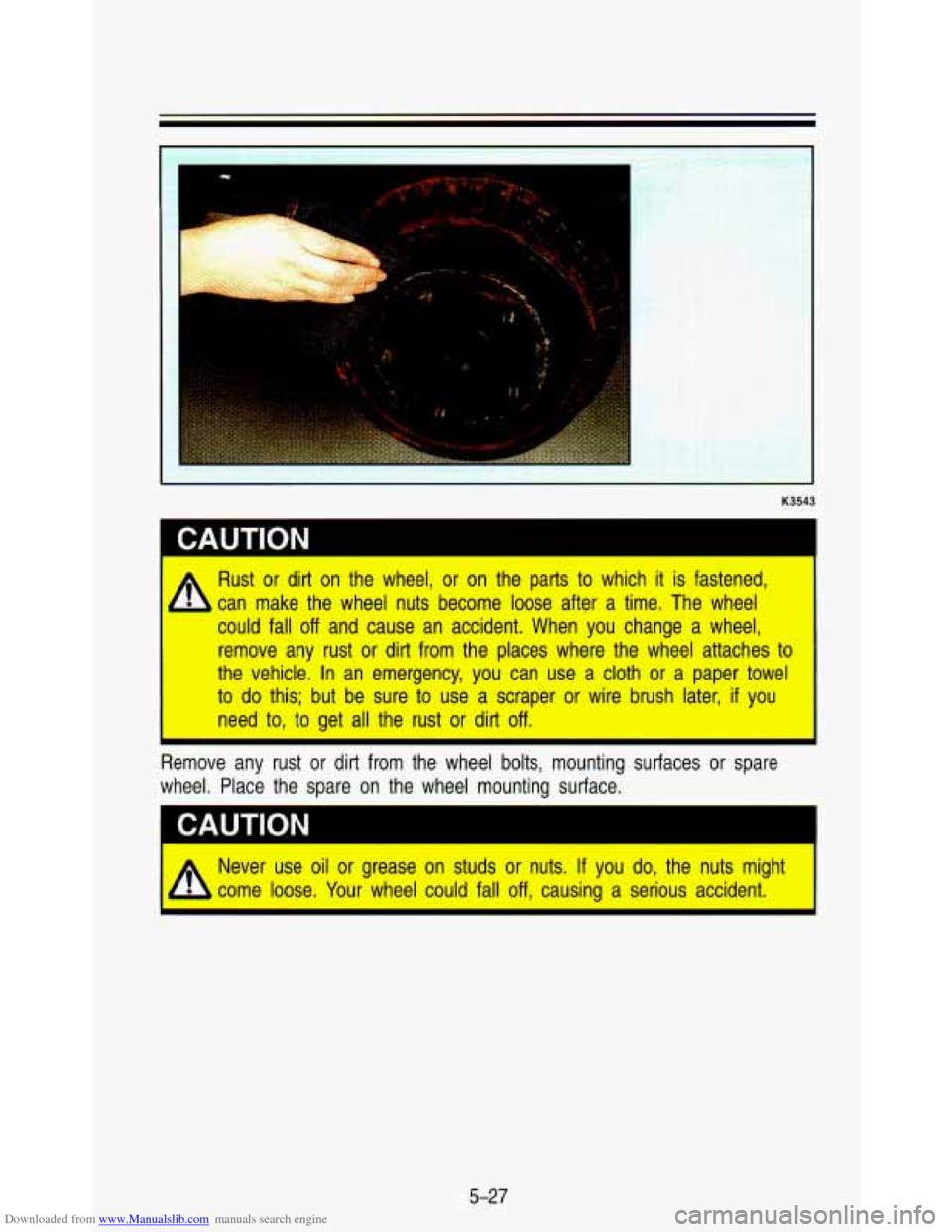
Downloaded from www.Manualslib.com manuals search engine K3543
A
Rust or dirt on the wheel, or on the parts to which it is fastened,
can make the wheel nuts become loose after a time. The wheel \
could fall
off and cause an accident. When you change a wheel,
remove any rust or dirt from the places where the wheel attac\
hes
to
to do this; but be sure to use a scraper or wire brush later, if you
I the vehicle. In an emergency, you can use a cloth or a paper towel
~ need to, to get all the rust or dirt off.
Remove any rust or dirt from the wheel bolts, mounting surfaces. or spare
wheel. Place the spare on the wheel mounting surface.
IL.
A
Never use oil or grease on studs or nuts. If you do, the nuts might
come loose. Your wheel could fall
off, causing a serious accident.
r
CAb I'ION
5-27
Page 250 of 345
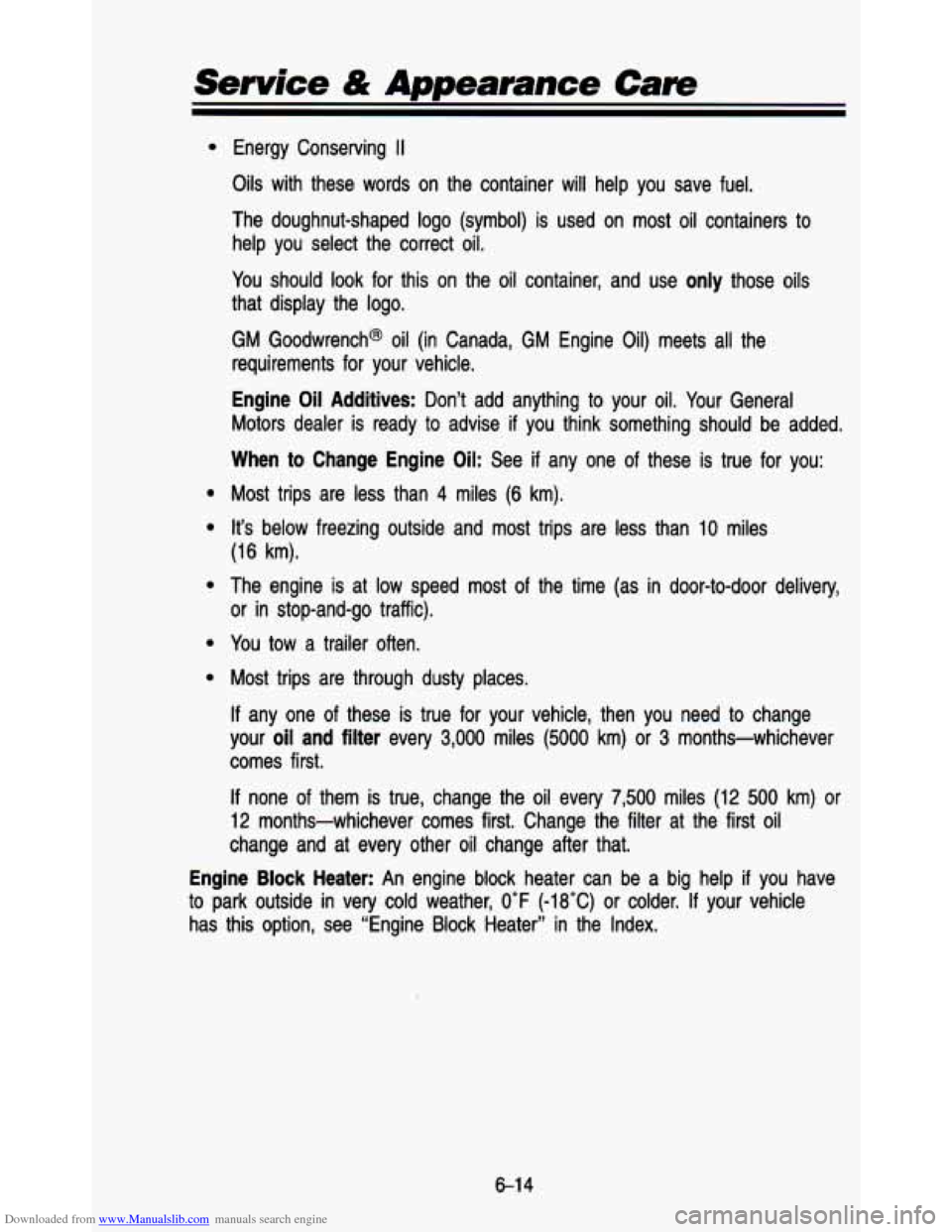
Downloaded from www.Manualslib.com manuals search engine Service & Appearance Care
e
e
e
e
e
e
Energy Conserving II
Oils with these words on the container will help you save fuel.
The doughnut-shaped logo (symbol) is used on most oil contain\
ers to
help you select the correct oil.
You should look for this on the oil container, and use
only those oils
that display the logo.
GM Goodwrench@ oil (in Canada, GM Engine Oil) meets all the \
requirements for your vehicle.
Engine Oil Additives: Don’t add anything to your oil. Your General
Motors dealer is ready to advise
if you think something should be added.
When to Change Engine Oil: See if any one of these is true for you:
Most trips are less than
4 miles (6 km).
It’s below freezing outside and most trips are less than 10 miles
(16 km).
The engine is at
low speed most of the time (as in door-to-door delivery,
or in stop-and-go traffic).
You
tow a trailer often.
Most trips are through dusty places.
If any one of these is true for your vehicle, then you need to change
your
oil and filter every 3,000 miles (5000 km) or 3 months-whichever
comes first.
If none of them is true, change the oil every 7,500 miles (12 500 km) or
12 months-whichever comes first. Change the filter at the first oil
change and at every other oil change after that.
Engine Block Heater: An engine block heater can be a big help if you have
to park outside in very cold weather,
0°F (-18°C) or colder. If your vehicle
has this option, see “Engine Block Heater” in the Index.
6-14
Page 256 of 345
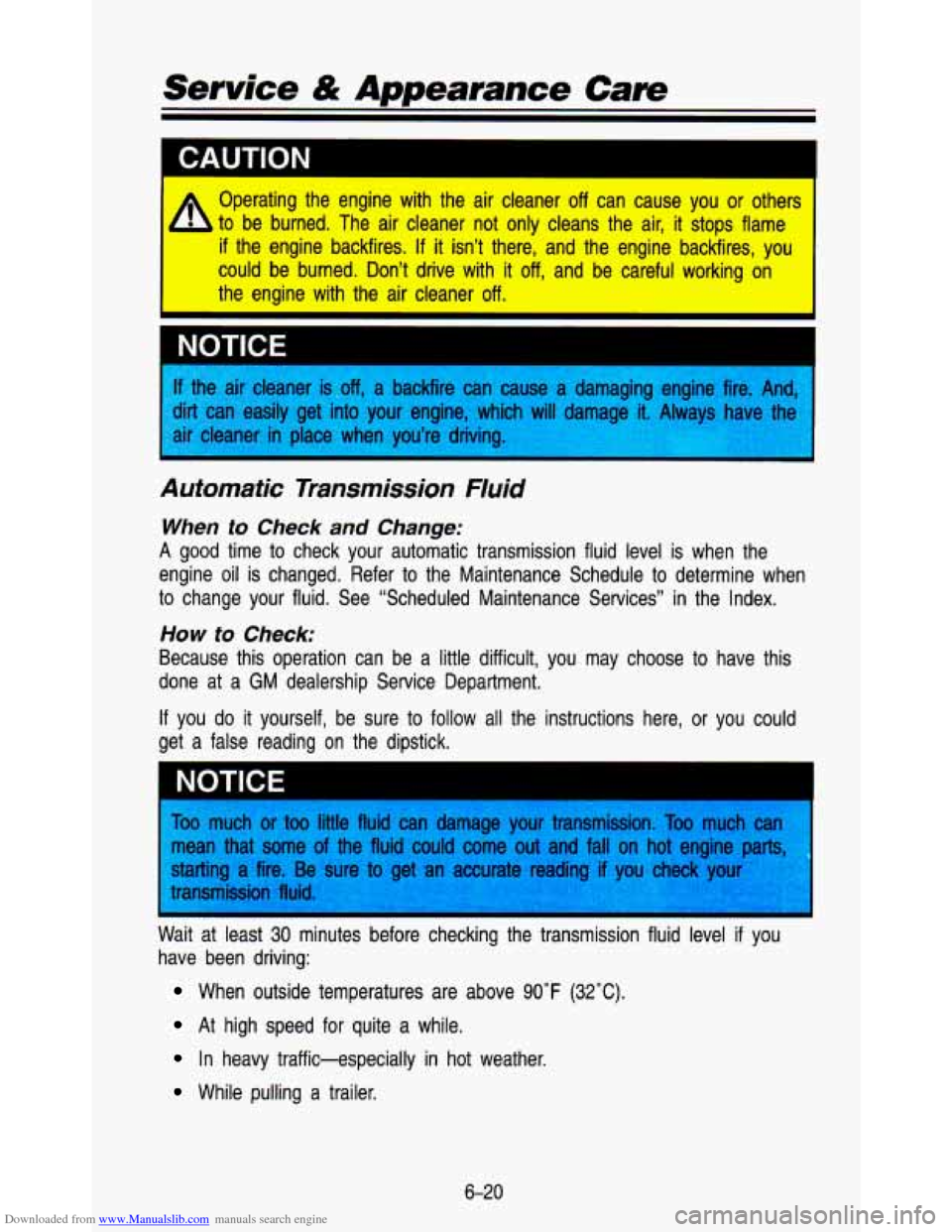
Downloaded from www.Manualslib.com manuals search engine Service & Appearance Care
h
Operating the engine with the air cleaner off can cause you or other!
to be burned. The air cleaner not only cleans the air, it stops flame
if the engine backfires. If it isn’t there, and the engine backfires, you
could be burned. Don’t drive with it off, and be careful working on
the engine with the air cleaner off.
If the air cleaner is off, a backfir
dirt can easily get into your engine,
air cleaner in place when you’re drivin $use a damaging engir
hicl
vill damage it. Na)
Automatic Transmission Nuid
When to Check and Change:
A good time to check your automatic transmission fluid level is when the
engine oil is changed. Refer to the Maintenance Schedule
to determine when
to change your fluid. See “Scheduled Maintenance Services” in the Index.
How to Check:
Because this operation can be a little difficult, you may choo\
se to have this
done at a
GM dealership Service Department.
If you do it yourself, be sure to follow all the instructions here, or you could
get a false reading on the dipstick.
Too much or too little fluid can damage your transmission. Too much can
mean that some of the fluid could come out and fall on hot engine part-
starting a fire. Be sure to get an accurate reading
if you check your
transmission fluid.
I
I
Wait at least 30 minutes before checking the transmission fluid level if you
have been driving:
When outside temperatures are above 90°F (32°C).
At high speed for quite a while.
In heavy traffic-especially in hot weather.
While pulling a trailer.
6-20
Page 270 of 345
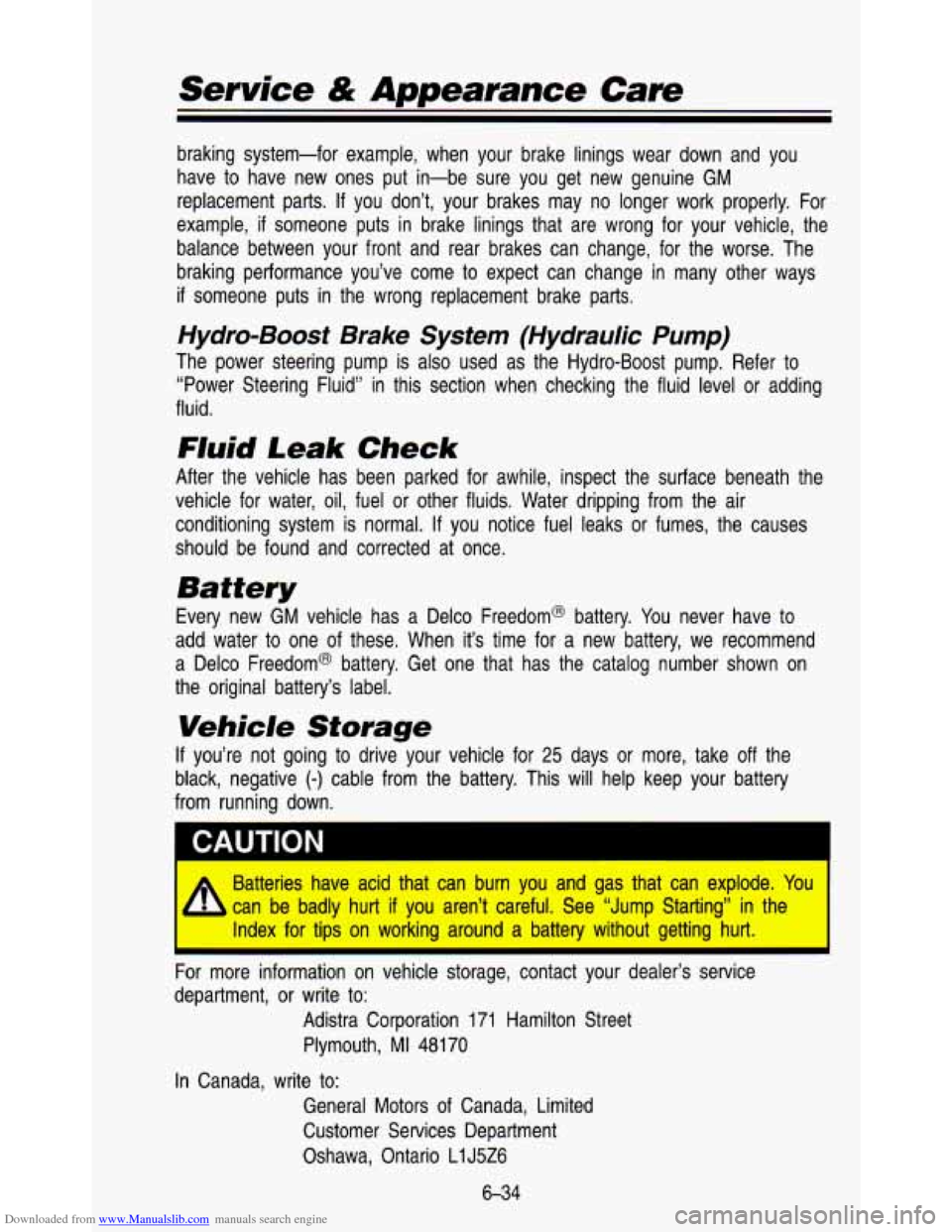
Downloaded from www.Manualslib.com manuals search engine Service & Appearance Care
braking system-for example, when your brake linings wear down and you
have
to have new ones put in-be sure you get new genuine GM
replacement parts.
If you don’t, your brakes may no longer work properly. For
example,
if someone puts in brake linings that are wrong for your vehicle, the
balance between your front and rear brakes can change, for the\
worse. The
braking performance you’ve come to expect can change in many\
other ways
if someone puts in the wrong replacement brake parts.
Hydro-Boost Brake System (Hydraulic Pump)
The power steering pump is also used as the Hydro-Boost pump. \
Refer to
“Power Steering Fluid” in this section when. checking the fluid level or adding
fluid.
Fluid Leak Check
After the vehicle has been parked for awhile, inspect the surf\
ace beneath the
vehicle for water, oil, fuel or other fluids. Water dripping f\
rom the air
conditioning system is normal. If you notice fuel leaks or fumes, the causes
should be found and corrected at once.
Battery
Every new GM vehicle has
add water
to one of these,
a Delco Freedom@ battery.
the original battery’s label. a Delco Freedom@ battery. You never have
to
When it’s time for a new battery, we recommend
Get one that has the catalog number shown on
Vehicle Storage
If you’re not going to drive your vehicle for 25 days or more, take off the
black, negative
(-) cable from the battery. This will help keep your battery
from running down.
I CAUTION
For more informarlon on vehicle storage, contact your dealer’\
s service
department, or write to:
Adistra Corporation 171 Hamilton Street Plymouth,
MI 48170
General Motors
of Canada, Limited
Customer Services Department
Oshawa, Ontario L1 J5Z6
In
Canada, write
to:
6-34